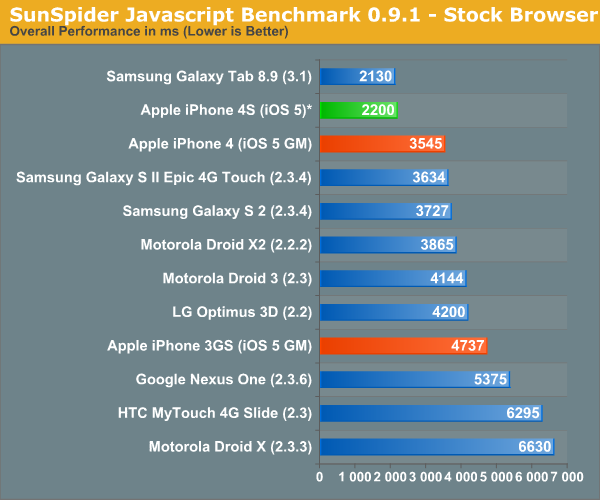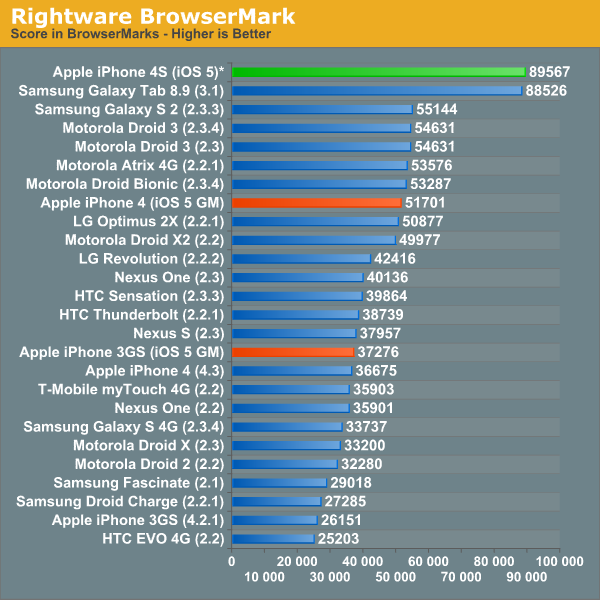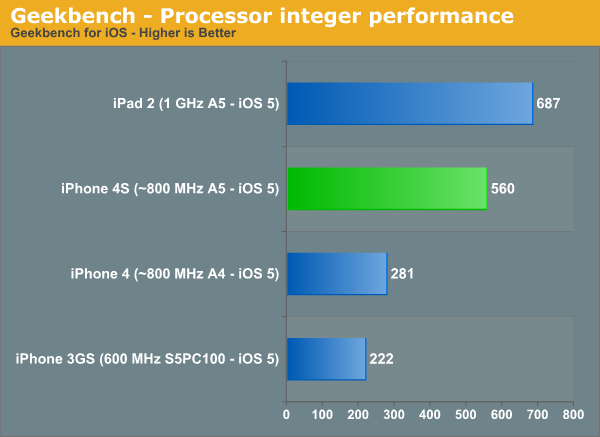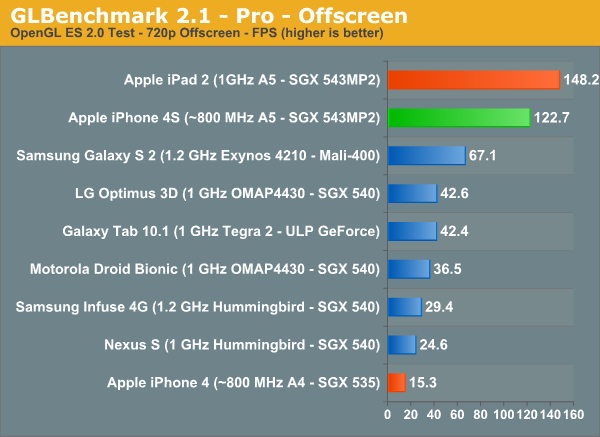iPhone 4S Preliminary Benchmarks: ~800MHz A5, Slightly Slower GPU than iPad 2, Still Very Fast
by Anand Lal Shimpi & Brian Klug on October 11, 2011 3:22 AM EST- Posted in
- Smartphones
- Apple
- Mobile
- iPhone 4S
- SoCs
Apple's ability to control the entire information chain, down to the point of limiting leaks, appears to be gradually slipping as it grows as a company. Case in point are the numerous hardware and performance leaks surrounding the newly launched iPhone 4S. Little did we know that several weeks ago we were staring at photos of the 4S' PCB, and more recently we've seen the first performance results from Apple's first A5 based smartphone thanks to a few eager users around the web. We've compiled these results here from various sources (all linked below) and compared them to our existing database of tests.
The results are pretty much as expected. Javascript performance finally catches up to Tegra 2 based Honeycomb devices, while general CPU performance is significantly higher than the iPhone 4. I suspect Ice Cream Sandwich will bridge the Android smartphone gap (the Honeycomb equipped Gtab 8.9 is here to give you an idea of where a more modern Android browser ends up).
Keep in mind that all of these tests measure performance of the software stack in addition to the hardware. In particular the web browser tests depend largely on browser optimizations, which is why we see differences between similar hardware running different browser versions. Also note that all results were run at stock, with the stock browser. Finally, although these browser tests were captured on video we'll still be running our official tests once our 4Ses arrive and will update accordingly.


Using some of the integer and fp tests of published Geekbench scores we can already conclude that Apple is shipping a lower clocked A5 in the iPhone 4S than it does in the iPad 2. This naturally makes sense as the iPhone 4S has a much smaller 5.25 Whr battery. Based on the Geekbench results it looks like the iPad 2 is clocked around 25% higher than the iPhone 4S, pegging the latter's clock speed at 800MHz.


A lower clock not only means higher yields from the factory, but likely a lower operating voltage as well. Dropping a CPU's core voltage, yields a greater-than-linear decrease in power consumption, making the marginal loss in clock speed a good choice. At a lower operating frequency than its Android competitors, Apple does have to exploit its strengths in software to avoid any tangible performance penalties. Apple has traditionally done this very well in the past, so I don't expect the loss of frequency to be a huge deal to the few who do cross-shop iOS and Android.
Unsurprisingly, memory bandwidth doesn't appear to have gone up either compared to the iPad 2's A5 (taking into account scaling due to CPU clock increases). The Samsung part number on the iPad 2's A5 indicates two LPDDR2-800 die on package, it's safe to assume that whatever Apple clocked the memory interface at in the iPad 2 remains unchanged in the iPhone 4S.
The GPU results tell a similar story courtesy of some early GLBenchmark 2.1 results. The 960 x 640 results are useless as they are bound by vsync at ~60 fps. Luckly GLBenchmark 2.1 added an off-screen render mode at 1280 x 720 where we can really see the differences between the iPad 2 and iPhone 4S A5 implementations:


Here the iPad 2 holds a ~21% performance advantage, which once again I assume to be all related to clock speed. Also note the huge advantage over the existing iPhone 4. The GPU power in the 4S should be more than enough to run any well written, current generation title at well north of 30 fps on its display.
We'll be reviewing the iPhone 4S in the coming weeks, stay tuned!
Source: GLBenchmark Database, Geekbench Database, Macrumors










216 Comments
View All Comments
kebab77 - Tuesday, October 11, 2011 - link
Brian, this article has #fail all over it I'm afraid.The video you took the iPhone 4S sunspider scores from clearly show they used Sunspider 0.9.1 so you can't - by your own admission - compare them to the 0.9 results you already have.
You should be comparing the iPhone 4S score from the video with others using 0.9.1 like here: http://www.bestsmartphone.com/2011/09/26/javascrip...
Anand Lal Shimpi - Tuesday, October 11, 2011 - link
Thank you for the heads up, a definite mistake on our part!We have updated the article to use our 0.9.1 results.
Take care,
Anand
name99 - Tuesday, October 11, 2011 - link
Anand, might I suggest some changes in how you benchmark future phones/tablets?Right now you are (IMHO) measuring a bunch of stuff that is not important to many people, and not measuring stuff that is important. Specifically, when I use my iPad (and to a lesser extent my iPhone) what I notice as slow is pretty much the same stuff that used to be what caused PCs to fell slow --- app launching and IO. But you have no benchmarks that measure these.
The lack of IO benchmarks is especially strange coming from THE SSD web site!
So let's think about this.
Measuring IO is, ultimately, not hard --- you simply need an app that reads and writes a bunch of data. Of course someone has to write the app(s). I suspect this will not be too hard if you ask around --- a benchmark app would be a good "my first app" for anyone trying to learn iOS/Android/WP7 programming. Even in the absence of such an app, you can get a feel for the write speed of flash by observing sync behavior. My experience, for example, has been that Apple has slowly ramped up the write speed of their flash from around 4MB/s in my first gen iPod nano, to 6 in my 3rd gen nano, to around 12 in my iPhone1 to around 18 in my iPhone4 and iPad1. Eyeballing the speed of a sync (say in syncing a few large movies to a device) is not the greatest way to benchmark, and it's not going to reveal the difference between a flash write speed of 18MB/s and 19MB/s, but it does at least give one an initial feel for how much faster the device will be (for this type of write operation) than what one might have used before.
Launch speed and suchlike are harder. One could be dumb and measure boot speed but, honestly, no-one gives a damn --- people reboot their phones what, once every six months or so. And you have the OS matching problem.
My solution is not ideal but, again, maybe is a start.
We argue that the browser is a common app across all platforms, and one people care about. So we
- manually quit the browser (and every other app) on the device
- power it off
- power it on again and leave it a minute or so to do its startup things
- START THE CLOCK
- start the browser with a URL that points to a very simple web page --- say a simple paragraph of text (I think, one way or another, all the browsers have a way you can launch them with a URL).
- wait for the text
- STOP THE CLOCK
The point of the URL and the text is to try to get around the problem of "when is the browser really launched" given that they all throw up splash screens and show UI before they're really alive.
One could imagine similar tests with other common apps. For example, with a movie player, quit the movie player manually while it's part way through a movie, then restart it and time how long till the movie is playable again. Another common app where you could do this is music playing.
I expect the first round of timing tests like this will reveal a bunch of complaints from partisans --- "you forgot that if you launch Safari in this way it is extra slow", "it's not fair to launch Android Video Player on that movie because most Android movies follow this spec which can use built-in HW, and that movie does not follow that spec", etc etc. But you (and all of us) will learn, and I think something useful will come out of it.
Certainly, for example, I love my iPad1. But I'm not so deluded as to claim that it is perfect. App launches are slow enough to be irritating --- especially so in the case of Videos and iPod --- which are both especially bad because they seem to be large enough that they're never retained in memory when switching to another app. Is this fixed in iPad2? Are Android devices as bad? Will Win8 tablets likewise be slow in app launching? I've no idea, but, honestly, that's the sort of thing technical reviews like yours should be telling us.
And do these numbers get worse with time as flash is filled up then items are deleted? How much worse? Do different OSs do a better or worse job in their flash GC? I don't know --- do you?
Truth is, personally I've very little interest in how many fps my iOS devices can deliver when playing games --- they have enough fps for all my needs. But I DO care about the places where a device pauses and makes me wait --- and a decent set of benchmarks should INFORM ME about those delays.
name99 - Tuesday, October 11, 2011 - link
"Apple's ability to control the entire information chain, down to the point of limiting leaks, appears to be gradually slipping as it grows as a company. Case in point are the numerous hardware and performance leaks surrounding the newly launched iPhone 4S. "I love you guys, but, seriously, this is just silly.
A whole bunch of unsubstantiated rumors, plenty of which were wrong, does not count as a "leak". What about all the iPhone 5 claims? The supposed larger screen? The tapered pearl design?
If there had been any sort of serious leaking of the iPhone4S specs before the launch, we would not have seen the spectacle, on launch day, of a million commenters telling us all how "disappointed" they were with the device --- they would have vented their "disappointment" in the weeks before the launch, and on the day would have been sullenly telling us all how right they were.
(But apart from that, great article --- thanks for the round up of the numbers, though, as I said in my previous comment --- we need IO numbers as well --- and heck, a test of the BT4 behavior would be nice if you can find some BT4 equipment to pair it with!)
Sind - Tuesday, October 11, 2011 - link
Not a huge fan of the article as I believe it is flawed. There is no doubt however that the 4S has some beef, but negating to even mention ICS or other options available now to Android users (different browsers, custom roms) doesn't do a consumer whom is looking for information any justice and seems more so like marketing. For instance my custom ROM at stock speeds with the stock browser on my Nexus S 2.3.7 gets 3964 in Sunspider. Failure to mention Googles goal to get a grip on fragmentation starting with ICS and the likely hood it will be showing up in the next month with a new phone on top of that does not help consumers and only Apple with this article. Got some page hits though right.Anand Lal Shimpi - Tuesday, October 11, 2011 - link
I believe we clearly mentioned that ICS should narrow if not eliminate this gap entirely, which was the point of including the Honeycomb result in the chart as well - to give a bit of a preview.Take care,
Anand
Captainobvvious - Tuesday, October 11, 2011 - link
Why stop there? Why not compare the iPhone 4S to next year's iPhone?ICS nor the Prime are released yet so why should they be compared? If you hack the hell out of your phone it MIGHT do slightly better, should they account for every configuration?
Stock vs. Stock... Sorry but that's the way it is.
You want to manipulate the results to somehow benefit the device you plunked your money down for. When the Prime and ICS is released (or in the case of the Prime... Announced!!!) then maybe it will be faster, until then it isn't.
jwcalla - Tuesday, October 11, 2011 - link
Stock vs. stock browser is about the only thing you can compare with the first set of benchmarks. You can pretty much draw no conclusions about the performance of the hardware.The GL benchmarks are more interesting and also more believable considering what we know about the PowerVR... but who knows how equitable 720p offscreen benchmarks are, especially for GPUs used in phones designed for SD.
morphon - Tuesday, October 11, 2011 - link
I agree with the GL benchmarks being the more important part. I don't know of that many games that are available and properly optimized for both, but that might be an interesting thing to figure out/investigate.However, Stock vs Stock is a little... odd.
Anyone who cares about browser performance on a dual-core Android device is probably running Opera Mobile anyway. It's solid, has excellent desktop sync, and very good Flash integration. It's not a mod, it's a recommended download from the Android Market and is free. You can just assign Opera to be the default web browser when it asks and bravo - done. Dual core performance. As I mentioned earlier, my non-overclocked, non-modded G2X (Tegra2, 2.3.5) running Opera gets the same Sunspider score as the iPhone 4S.
Thing is - it's NORMAL to run a different browser on Android. Everyone I know is running DolphinHD, Opera, or XScope. It's like putting Chrome on your desktop. Not a mod. Normal behavior. Just testing against the stock browser gives a non-representative result. Doesn't reflect the real world.
But I am totally on board with your second paragraph. Gaming performance is going to be the real test. If the A5 allows game developers to do more/better than what ships in the current Android superphones, then that's where the time and effort will be spent.
doobydoo - Sunday, October 16, 2011 - link
Well, hold on a bit there my Android - biased -friend. You can't then take a specific downloaded browser for Android and then compare it to the STOCK iphone browser, now can you?That would defeat all of your own logic.
If you did do that, the iPhone would be faster again.